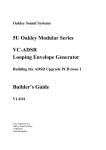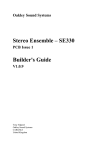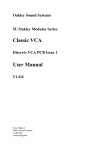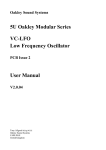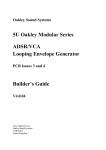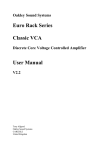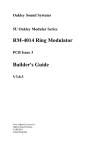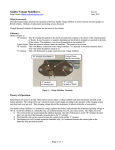Download Builder`s Guide - Oakley Sound Systems
Transcript
Oakley Sound Systems Rack Power Supply Unit (RPSU) PCB Issue 1 Builder's Guide V1.0.2 Tony Allgood Oakley Sound Systems CARLISLE United Kingdom 1 Introduction This is the Project Builder's Guide for issue 1 of the RPSU circuit board from Oakley Sound. This document contains a full parts list for the components needed to populate the board and some basic testing methods. You will also need the RPSU User Manual which gives details on how to use the module as well as example wiring diagrams. This can be found on the RPSU webpage. For general information regarding where to get parts and suggested part numbers please see our useful Parts Guide at http://www.oakleysound.com/parts.pdf. For general information on how to build our modules, including circuit board population, mounting front panel components and making up board interconnects please see our Construction Guide at http://www.oakleysound.com/construct.pdf. A completed RPSU board built in full wave rectification mode and fitted with Molex KK headers 2 Parts List The components are grouped into values, the order of the component names is of no particular consequence. A quick note on European part descriptions: For resistors: R is shorthand for ohm. K is shorthand for kilo-ohm. M is shorthand for megaohm For capacitors: 1uF = 1,000nF = 1,000,000pF. Sometimes the F is not included on the circuit diagram to indicate a capacitor's value, ie. 100n = 100nF. To prevent loss of the small ‘.’as the decimal point, a convention of inserting the unit in its place is used. eg. 4R7 is a 4.7 ohm, 4K7 is a 4700 ohm resistor, 4n7 is a 4.7 nF capacitor. Resistors All resistors are 0.25W 1% metal film or better. 47R 240R 2K2 10K R5* R3, R4 R1, R2 R6 * If the RPSU is to be used within a project featuring an internal mains transformer then R5 should be a wire link and not a resistor. A resistor lead clipping is normally long enough for this purpose. If +/-12V operation is required then you should make both R1 and R2 each a 1K5 resistor. Capacitors 100nF, 63V multilayer axial ceramic 10uF, 35V or 50V electrolytic 22uF, 35V or 50V electrolytic 1000uF, 35V or 50V electrolytic C1, C4, C5, C6 C2, C3, C7, C8 C13 C9, C10, C11, C12 C9 to C11 are radial types and have standard wire ended leads. Lead spacing is either 5mm or 7.5mm. Do not get 'push-fit' types as their pins are too large to fit into the PCB. Ensure they have a ripple rating of at least 750mA. 3 Discrete Semiconductors 1N4002 or 1N4004 D1, D2, D3, D4, D5, D6, D11 Because of space limitations D5 and D6 have to be fitted to the board after fitting the PSU1 and PSU2 headers. 1N5401 D7, D8, D9, D10 D9 and D10 do not need to be fitted if you are using a single phase wall wart or line lump. However, for full wave rectification D9 and D10 are required. So if you are using a split output line lump or an internal transformer with twin secondaries D9 and D10 have to be fitted. LED This is an optional part and can either be fitted direct to the board for fault finding use or to the front panel as a 'power on' indicator. For the latter I would suggest that you fit 2-way 0.1” KK or MTA header on the board in place of the LED. 5mm green LED AC Integrated Circuits LM317T 1A variable regulator LM337T 1A variable regulator U1 U2 Ensure that both devices are TO-220 types and not any surface mounting or TO-3 packages. I much prefer the devices that are made by National Semiconductor. They are available from other manufacturers but National's devices have a thicker and more rigid heatsink tab. Do not fit solder these into the board just yet. They are only to be soldered once the board is fitted to the panel. See the section on mounting the RPSU board later in this document. 4 Miscellaneous 1K multiturn cermet trimmer 0.156” Molex KK 4-way header 800mA antisurge 20mm fuse 20mm fuseholder PC mount 4-way screw terminal 5mm POS, NEG PSU1, PSU2 F1*, F2 F1*, F2 POWER, SWITCH 2 off TO-220 insulator 2 off TO-220 insulating bush Heatsink paste For mounting of U1 and U2 to panel For mounting of U1 and U2 to panel For mounting of U1 and U2 to panel if using mica plates Suitable power switch Suitable power socket Various screws, washers and other mounting hardware. * If you are using the recommended wall-wart, or single phase line lump, then fuseholder F1 and it associating fuse does not need to be fitted. F1 and F2 are only required if you are using a split output line lump or internal mains transformer for full wave rectification. 5 Attaching the Power Devices In this build the two regulators are insulated from the panel with grey insulating pads. Note the thinner metal tab on the upper device compared to the thicker National LM337T. The RPSU PCB needs to be fitted to your case metalwork. Use the PCB as a template for the four holes needed for the mounting pillars. The board should be spaced high enough off the panel so as to not short out any of the components' leads should the board be flexed downward. However, they should also not be too long so that the leads from the two regulators can't reach through the board to be soldered. I find an 8mm spacer works very well. Now you need to prepare the leads of the two power devices. The three legs need to be bent upwards so that the PCB can be fitted over them. Note that the top surface of the device is marked with the name of the component and it is the flat side on the bottom of the device that will be in contact with the panel. You should be able to see that the leads have a thicker section close to the body of the device. Make a 90 degree bend upwards at the point where the lead thickness changes. Do this for all three legs of the device. Remove the board from the panel and fit the power devices to the board by poking their legs up through the bottom of the board. Do not solder them but fit the board back into place. Use the hole in each regulator to mark out where you need to drill the mounting hole for the two devices. Now remove the board and regulators. Carefully drill a 3.5mm hole in the panel for 6 each of the regulators. Clear off any swarf and, twisting with your hand only, use an 8mm drill bit to lightly deburr the edges of the holes. There should be no bumps around the holes. The regulators are both TO-220 devices. They both need to be fitted to the panel mechanically and thermally but not electrically. That is the metal tab on each device that will be mounted to the panel should not make electrical contact with the metal panel. To achieve both thermal transfer and electrical insulation we use an insulator. These can be made of a 'soft' flexible material in the form of an insulating pad or a rigid thin glass like plate made from mica. If using the mica you will also need to use heat transfer paste. Since the paste is somewhat messy I recommend you use the insulating pads. Both types are normally available in 'mounting kits'. Also in the kit is a mounting bush. This top hat shaped piece of stiff plastic prevents the mounting screw from touching the regulator's metal tab. Now place the mounting bush into the hole of the transistor, with the flange of the bush lying on the top side of the device. Take one of the insulating pads and place it against the rear of the regulator. Match up the hole in the pad with the bush that is sticking out from the underside of the tab. You may find the mounting bush does not stick out from the underside of the regulator. This is fine – you will just need to be a little more careful that the pad doesn't slip when you fasten the device to the panel. However, you may find that any plastic that does stick out is too big to fit into the hole in the insulating pad. I find that carefully removing the excess plastic rim from the bush, with a very sharp knife, is the best way to solve this problem. If you do have part of the bush sticking out you may also want to check at this point that the bush will fit into your panel hole. If not, you can either make the hole bigger, or trim the excess plastic of the bush. Now place the power device, bush and pad flat against the rear of the panel so that the bush fits into the panel. Make sure the pad does not slip out of place when you do this. Insert a 10mm countersunk M3 screw into the hole from the reverse side of the panel, and fit a spring washer and nut onto the screw but do not tighten fully. Do the same for the other regulator making sure, of course, that each one is in the correct hole. Now if you have done all this correctly, you should find that the when the power supply PCB is fitted back onto the four screws, you can coax the power devices’ legs through the respective solder pads on the board. With both the board and transistors secured to the panel with their mounting hardware you can solder the regulators' leads from the top side of the board. 7 Testing and Calibration After wiring the unit according to the instructions given in the Users Manual you should apply power to the unit. Check that no device is running hot. Any sign of smoke or strange smells turn off the power immediately and recheck the all the external wiring first, and then the components on the board. If you have fitted the AC LED it should now be lit. Assuming everything is OK so far, it is time to check the output voltages. Measure the output voltage with respect to ground. This means connect your black lead of your voltmeter to the pad marked EARTH on the CPSU board. Now measure the voltage at pin one of the header, the top one, it should be positive and be somewhere between +13V and +18V. Check pin 4, the bottom pin, and it should be somewhere between -13V and -18V. You should now adjust the voltages with the trimmers (multiturn presets) on the board. Adjust POS to make pin 1 equal +15.00V. Adjust NEG to make pin 4 equal to -15.00V. The voltages will vary a little with load. That is, it will change marginally depending on how many modules you connect up to the power supply board. Feel free to re-adjust the trimmers when you add more modules to your project. 8 Final Comments I hope you that the Oakley RPSU lives up to your expectations and provides you with a reliable source of power for your project. If you have any questions about the module, an excellent source of support is the Oakley Sound Forum at Muffwiggler.com. Paul Darlow and I are on this group, as well as many other users and builders of Oakley modules. If you have a comment about this user manual, or have a found a mistake in it, then please do let me know. Last but not least, can I say a big thank you to all of you who have helped and inspired me over the years. Thanks especially to all those nice people at Muff's and the Synth-DIY and Analogue Heaven mailing lists. Tony Allgood at Oakley Sound Cumbria, UK © March 2013 9










